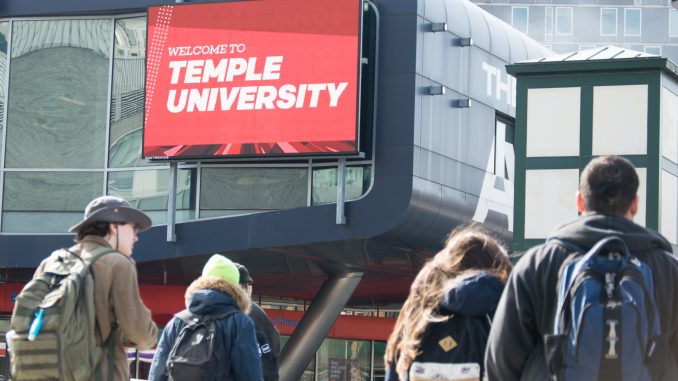
Even though Temple advertises itself as a diverse university, its marketing and admissions teams said they don’t apply specific efforts to attract minority students to the school. Instead, officials said they reach out to places that are already diverse to recruit students.
Two weeks ago, The Temple News explored data focusing on the changing racial demographics of the student body starting in 2005-06. Even though the student population has grown and the university has repeatedly broken its record for most applications, some minority groups take up less of the student population. White students remained consistently between 55 and 61 percent of the student body. The percent of Black students declined by about 6 percent while the number of international students almost tripled.
The next step is to find out why.
There was about a 34 percent increase in applications to Temple from 2014 to 2017. The university does not have data for the racial, socioeconomic and geographic breakdown of applicants.
The university’s most recent Common Data Set from 2015-16 lists factors of “relative importance” in admissions decisions. For factors like religion, the university marked that is “not considered” for admissions. But the row in the form about whether race is considered has not been filled out since the 2014-15 Common Data Set, when the university logged that race and ethnicity were considered in admissions decisions. In each Common Data Set from 2002-03 to 2011-12, the university marked race and ethnicity as “not considered” in admissions decisions.
Director of Admissions Karin Mormando said the number of applicants in every demographic has increased, but Temple’s recent “momentum” for factors like athletics, academics and on-campus development may attract students who wouldn’t have been interested in the university otherwise.
Between September and January, Temple received more than 880 million impressions through media coverage and five nationally televised football appearances during the 2016 football season — when Temple tied the record set in 2015 for most wins in school history. Temple received its highest ranking in the 2016 U.S. News & World Report’s Best Colleges report, and its research was named to the Carnegie Classification of Institutions of Higher Education’s highest standard last February, a classification shared by four percent of four-year institutions in the nation. Main Campus is also currently undergoing 11 renovations.
“If we go back 15 to 20 years, the amount of physical and capital development on this campus has been pretty significant,” Mormando said.
Emily Spitale, the associate vice president of strategic marketing and communications, said the marketing department has used new techniques to appeal to prospective students within the last three or four years, like looking at national research to better understand prospective students’ goals when researching higher education institutions. In 2015, Temple also began to use sites like BuzzFeed to create sponsored content and reach out to high school freshmen and sophomores who are just beginning to consider college.
Spitale said national research states that students are often curious about universities’ degrees and programs, affordability, location and student life. She said the marketing department will use social media to emphasize these points.
Temple’s diversity is highlighted during its marketing campaigns “all the time” and answers prospective students’ questions about what on-campus life is like, she added.
Ashlei Gentry, the president of the Black Student Union, said the diverse image Temple portrays doesn’t match her initial experience on Main Campus.
She added that BSU programs and meetings are packed in the beginning of the academic year because Black students feel like they need to seek out peers like themselves — the same reason she joined the student organization three years ago.
“In my classes, there are very few African American students,” Gentry, a senior political science major, said. “If you’re just walking [on campus], you see Black people because you know where they are. But at first I didn’t know where they were.”
Spitale said the marketing team does not target specific student demographics for recruitment, but interacts with interested students who were recruited by admissions counselors and seek out Temple through various platforms.
William Black, the senior vice provost of enrollment management, said in March that Temple recruits “a diverse applicant pool” in places like Atlanta and Washington, D.C., and this strategy is built into the Office of Admissions’ strategy from the start.
Mormando said her goal is to enroll the most academically talented class she can, no matter the size of the applicant pool.
She added that the suggested GPA and standardized test scores for applicants have increased over the last four years. The Temple Option, which allows students to answer “self-reflective” questions through writing instead of submitting test scores, was offered for the first time in 2014.
That year, the National Center for Fair & Open Testing calculated that every student who scored lower than their peers on the SATs was in a lower income bracket.
Mormando said the alternative admissions method can be seen as a way to appeal to “diverse populations,” on a racial, socioeconomic and geographic level.
“Ultimately, I’m looking to recruit a class of future alumni,” Mormando said. “We really have to hone in on that academic experience.”
Grace Shallow can be reached at grace.shallow@temple.edu or on Twitter @grace_shallow.
Julie Christie contributed reporting.



Be the first to comment